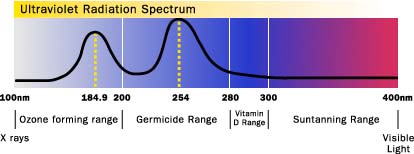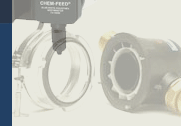
Discovery
of Ultraviolet Light
In
1666 Isaac Newton allowed a sunbeam to enter into
a darkened room through a small hole, pass through
a prism, and fall upon the opposite wall. What
appeared was a spectrum of very vivid and intense
colours. By means of further experiments he was
able to prove that white light was made up of
several different components.
In
1800, Sir William Hershel discovered that the
solar spectrum extended out beyond the portion
which was visible to the human eye. He formed
a spectrum and passed a thermometer through
the various colours and compared the reading
with that of a similar thermometer shaded from
the spectrum. He found a rise in temperature
as he passed from the violet to the red
end. Still more astounding was the fact that the
thermometer showed a higher temperature
in the dark space beyond the red than it did in
any part of the visible spectrum. This meant
that there was some intense radiation beyond
the region which was visible to the eye. This
invisible radiation beyond the red end of
the spectrum is now known as infrared radiation.
In
1801, J.W. Ritter investigated the other end of
the spectrum and showed that chemical action
was caused by some form of energy in the dark
portion beyond the violet. This region is
now known as ultraviolet.
Sources
of Ultraviolet
The
sources of ultraviolet may be didived into two
classes: natural and artificial. The most important
source of ultraviolet is the sun. The artificial
source comprises a variety of arcs and incandescent
lamps.

Ultraviolet disinfection
of water generally employs low pressure mercury
vapour lamps. They generate short wave ultraviolet
in the region of 253.7 nanometers, which is lethal
to micro-organisms including bacteria, protozoa,
viruses, moulds, yeasts, nematode eggs and algae.
Ultraviolet
Dosage
Ultraviolet
dosage is measured in microwatt seconds per square
centimetre (uWs/cm2). The higher
the microwatt, the higher the dosage, the longer
the exposure time, the higher the dosage.
Increase the area exposed to the ultraviolet
radiation the higher the kill.
Approximate
dosage rates to kill:
- Bacteria
2,500 - 26,400 uWs/cm2
- Yeast
6,600 - 17,600 uWs/cm2
- Algae 11,000 - 330,000
uWs/cm2
- Viruses
2,500 - 22,000 uWs/cm2
The
U.S. Public Health Service published a policy
stating the dosage requirement for drinking
water should be approximately 16,000 uWs/c2.
This statement has formed the basis for
a World Wide Standard. Every UVTA(TM) UV
unit emits in excess of 36,000 uWs/cm2,
which is more than double the recommended dosage
of the U.S. Public Health Service.
|





